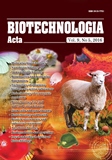"Biotechnologia Acta" V. 9, No 5, 2016
https://doi.org/10.15407/biotech9.05.065
Р. 64-69, Bibliography 21, English
Universal Decimal Classification: 581.134.1

ICP-MS ANALYSIS OF WHEAT BREAD CARRYING THE GPC-B1 GENE OF Triticum turgidum SSP. dicoccoides
S. Yu. Pokhylko 1, 2, V. V. Schwartau 3, L. M. Mykhalska 3, O. M. Dugan 2, B. V. Morgun 1, 3
1 Institute of Cell Biology and Genetic Engineering of theNational Academy of Sciences of Ukraine, Kyiv
2 National Technical University of Ukraine “Ihor Sikorsky Kyiv Polytechnic Institute”, Kyiv
3 Institute of Plant Physiology and Genetics of the National Academy of Sciences of Ukraine, Kyiv
The aim of work was the analysis of effect of the gene Gpc-B1, introgressed from wild spelt Triticum turgidum ssp. dicoccoides, on the presence of biologically important elements in wheat winter bread hybrid families of generations F4 and F5. The accumulation of metals in ripe and unripe grains was measured on a mass spectrometer with inductively coupled plasma ICP-MS Agilent 7700x. It was found that the expressing gene significantly increased the content of trace elements Fe, Mn, Zn and Cu in ripe wheat kernels on average by 50–70%, while the increase of Mg, Ca defined by an average of 20–40%. Minerals enrichment confirmed during grain development and ripening provided not only biofortification for the future harvest, but also potentially enhanced the resistance of plants to diseases and formation of seedlings with more efficient use of nitrogen.
Key words: Triticum turgidum, biofortification, wheat bread, gene Gpc-B1.
© Palladin Institute of Biochemistry of the National Academy of Sciences of Ukraine, 2016
References
1. Morgun V. V., Schwartau V. V., Kyryzyy D. A. The physiological basis for the formation of high productivity of cereals. Physiol. Biochem. Cultivat. Plants. 2010, 42 (5), 371–392.
2. Gernand A. D., Schulze K. J., Stewart C. P., West K. P. Jr., Christian P. Micronutrient deficiencies in pregnancy worldwide: health effects and prevention. Nat. Rev. Endocrinol., 2016 May. 2016, 12 (5), 274–289.
3. White P. J., Broadley M. R. Biofortification of crops with seven mineral elements often lacking in human diets iron, zinc, copper, calcium, magnesium, selenium and iodine. New Phytologist. 2009, 182 (1), 49–84.
4. WHO, World health statistics 2015. World Health Organization, Geneva, Switzerland. http://apps.who.int/iris/bitstream/10665/170250/1/9789240694439_eng.pdf.
5. Cakmak I., Kalayci M., Kaya Y., Torun A. A., Aydin N., Wang Y., Arisoy Z., Erdem H., Yazici A., Gokmen O., Ozturk L., Horst W. J. Biofortification and localization of zinc in wheat grain. J. Agric. Food Chem. 2010, 58 (16), 9092–9102.
6. Welch R. M., Allaway W. H., House W. A., Kubota J. Geographic distribution of trace element problems. Micronutrients in Agriculture: Second Edition. 1991, V. 4, Р. 31–57.
7. Joppa L. R., Du C., Hart G. E., Hareland G. A. Mapping gene(s) for grain protein in tetraploid wheat (Triticum turgidum L.) using a population of recombinant inbred chromosome lines. Crop Sci. 1997, V. 37, Р. 1586–1589.
8. Velu G., Ortiz-Monasterio I., Cakmak I., Hao Y., Singh R. P. Bioforti?cation strategies to increase grain zinc and iron concentrations in wheat. J. Cereal Sci. 2014, 59 (3), 365–372.
9. Tabbita F., Lewis S., Vouilloz J., Ortega M., Kade M., Abbate P., Barneix A. J. Effects of the Gpc-B1 locus on high grain protein content introgressed into Argentinean wheat germplasm. Plant Breed. 2013, V. 132, P. 48–52.
10. Uauy C., Brevis J., Dubcovsky J. The high grain protein content gene Gpc-B1 accelerates senescence and has pleiotropic effects on protein content in wheat. J. Exp. Bot. 2006, V. 57, Р. 2785–2794.
11. Card S., Cathcart J., Huang J. The micronutrient and trace element status of crops grown on the Alberta soil quality benchmark sites: AESA soil quality monitoring. Program Alberta Agriculture, Food and Rural Development Conservation and Development Branch; AAFRD, Edmonton. 2005, Р. 63.
12. Abbaspour N., Hurrell R., Kelishadi R. Review on iron and its importance for human health. J. Res. Med. Sci., 2014. 2014, 19 (2), 164–174.
13. Andrews N. C. Iron metabolism: iron deficiency and iron overload. Annu. Rev. Genomics Hum. Genet. 2000, V. 1, Р. 75–98.
14. Oliveira F., Rocha S., Fernandes R. Iron metabolism: from health to disease. J. Clin. Lab. Anal. 2014, 28 (3), 210–218.
15. Cabrera ?. J. R. Zinc, aging, and immunosenescence: an overview. Pathobiol. Aging Age-related Dis. 2015, V. 5, P. 25592. doi: 10.3402/pba.v5.25592.
16. Roohani N., Hurrell R., Kelishadi R., Schulin R. Zinc and its importance for human health: An integrative review. J. Res Med Sci. 2013, 18 (2), 144–157.
17. Krej?ov? A., Ludv?kov? I., ?ernohorsk? T., Pouzar M. Elemental analysis of nutritional preparations by inductively coupled plasma mass and optical emission spectrometry. Food Chem. 2012, 132 (1), 588–596.
18. Persson D. P., Hansen T. H., Laursen K. H., Husted S., Schjoerring J. K. ICP-MS and LC-ICP-MS for analysis of trace element content and speciation in cereal grains. Plant Metabolomics, series Methods in Molecular Biology 2012, V. 860, Р. 193–211.
19. Polishchuk S. S., Kyrdohlo E. K., Mykhalska L. M., Morgun B. V., Pokhylko S. Yu., Rybalka О. І., Schwartau V. V. Quantification of trace elements Fe, Zn, Mn, Se in hull-less barley grain. Agric. Sci. Pract. 2016, 3 (1), 49–54.
20. Rayman M. P. Selenium and human health. The Lancet. 2012, 379 (9822), 1256–1268.
21. Selenium: chemistry, analysis, function and effects. Ed. by V. Preedy; Royal Society of Chemistry. 2015, 642 р.

